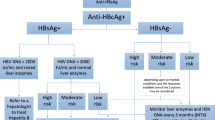Abstract
Background
The burden of hepatitis B virus (HBV) infection in China is high. The safety and efficacy of secukinumab in psoriasis patients with HBV infection have not been fully elucidated.
Objectives
To investigate the safety and efficacy of secukinumab in psoriasis patients with HBV infection in China.
Materials & Methods
In this retrospective study, 20 psoriasis patients with HBV infection were identified, all of whom had been treated with secukinumab for ≥24 weeks
Results
Four patients had chronic inactive HBV infection, two patients had occult HBV infection, and the other 14 patients had resolved HBV infection. The HBV-DNA load and HBV markers measured at baseline and Week 24 showed no viral reactivation. Nineteen patients showed normal levels of liver enzymes after 24 weeks of therapy. However, one patient with resolved HBV infection and fatty liver with elevated baseline liver enzymes experienced hepatitis, with negative HBV load at baseline and Week 24. All patients showed a significant improvement in the Psoriasis Area and Severity Index (−13.35 ± 7.41: p < 0.0001), per cent of body surface area (−17.11 ± 17: p = 0.0002), Investigator Global Assessment (−2.55 ± 0.94: p < 0.0001), and Dermatology Life Quality Index (−12.3 ± 7.39; p < 0.0001)
Conclusion
Secukinumab showed good efficacy in psoriasis patients with HBV infection. Chronic, inactive, occult and resolved HBV infection may not increase the risk of hepatitis during secukinumab treatment. Patients with poor baseline liver function, without any intervention during secukinumab treatment, may experience hepatitis. Periodic monitoring with HBV markers, HBV-DNA load, and serological liver function tests is necessary during secukinumab treatment
Similar content being viewed by others
References
Gudjonsson JE, Elder JT. Psoriasis: epidemiology. Clin Dermatol 2007; 25: 53546.
Blauvelt A. Safety of secukinumab in the treatment of psoriasis. Expert Opin Drug Saf 2016; 15: 1413–20.
Lonnberg AS, Zachariae C, Skov L. Targeting of interleukin-17 in the treatment of psoriasis. Clin Cosmet Investig Dermatol 2014; 7: 251–9.
Sanford M, McKeage K. Secukinumab: first global approval. Drugs 2015; 75: 329–38.
Gaffen SL, Jain R, Garg AV, Cua DJ. The IL-23-IL-17 immune axis: from mechanisms to therapeutic testing. Nat Rev Immunol 2014; 14: 585–600.
Bao S, Zheng J, Shi G. The role of T helper 17 cells in the pathogenesis of hepatitis B virus-related liver cirrhosis (Review). Mol Med Rep 2017; 16: 3713–9.
Trepo C, Chan HL, Lok A. Hepatitis B virus infection. Lancet 2014; 384: 205343.
Cannizzaro MV, Franceschini C, Esposito M, Bianchi L, Giunta A. Hepatitis B reactivation in psoriasis patients treated with anti-TNF agents: prevention and management. Psoriasis 2017; 7: 35–40.
Wang H, Men P, Xiao Y, et al. Hepatitis B infection in the general population of China: a systematic review and meta-analysis. BMC Infect Dis 2019; 19: 811.
Manalo IF, Gilbert KE, Wu JJ. Preventing hepatitis B reactivation associated with immunosuppressive drug treatments for psoriasis. J Am Acad Dermatol 2015; 73: 881–2.
Snast I, Atzmony L, Braun M, Hodak E, Pavlovsky L. Risk for hepatitis B and C virus reactivation in patients with psoriasis on biologic therapies: a retrospective cohort study and systematic review of the literature. J Am Acad Dermatol 2017; 77: 88–97.e85.
Hoofnagle JH. Reactivation of hepatitis B. Hepatology 2009; 49: S156–165.
Langley RG, Elewski BE, Lebwohl M, et al. Secukinumab in plaque psoriasis — results of two phase 3 trials. N Engl J Med 2014; 371: 326–38.
Thaci D, Blauvelt A, Reich K, et al. Secukinumab is superior to ustekinumab in clearing skin of subjects with moderate to severe plaque psoriasis: CLEAR, a randomized controlled trial. J Am Acad Dermatol 2015; 73: 400–9.
Raimondo A, Balato A, Megna M, Balato N. Limitations of current monoclonal antibodies for plaque-type psoriasis and an outlook for the future. Expert Opin Biol Ther 2018; 18: 605–7.
Gisondi P, Altomare G, Ayala F, et al. Italian guidelines on the systemic treatments of moderate-to-severe plaque psoriasis. J Eur Acad Dermatol Venereol 2017; 31: 774–90.
Kaushik SB, Lebwohl MG. Psoriasis: Which therapy for which patient: Psoriasis comorbidities and preferred systemic agents. J Am Acad Dermatol 2019; 80: 2740.
Kaushik SB, Lebwohl MG. Psoriasis: which therapy for which patient: focus on special populations and chronic infections. J Am Acad Dermatol 2019; 80: 43–53.
van Denderen JC, Blom GJ, van der Horst-Bruinsma IE, Dijkmans BA, Nurmohamed MT. Elevated liver enzymes in patients with ankylosing spondylitis treated with etanercept. Clin Rheumatol 2012; 31: 1677–82.
Beringer A, Miossec P. IL-17 and IL-17-producing cells and liver diseases, with focus on autoimmune liver diseases. Autoimmun Rev 2018; 17: 1176–85.
Chiu HY, Hui RC, Huang YH, et al. Safety profile of secukinumab in treatment of patients with psoriasis and concurrent hepatitis B or C: a multicentric prospective cohort study. Acta Derm Venereol 2018; 98: 829–34.
Yanagihara S, Sugita K, Yoshida Y, Tsuruta D, Yamamoto O. Psoriasis vulgaris in a hepatitis B virus carrier successfully treated with secukinumab and entecavir combination therapy. Eur J Dermatol 2017; 27: 185–6.
Acknowledgments
The patients in this manuscript have given written informed consent to publication of their case details.
Funding
This work was sponsored by grants from National Natural Science Foundation of China (No. 81872522, 82073429, 82003334), Innovation Program of Shanghai Municipal Education Commission (No.2019-01-07-00-07-E00046), the Program of Science and Technology Commission of Shanghai Municipality (No. 18140901800), Excellent Subject Leader Program of Shanghai Municipal Commission of Health and Family Planning (No. 2018BR30), Clinical Research Program of Shanghai Hospital Development Center (No. SHDC2020CR1014B, SHDC12018X06) and Program of Shanghai Academic Research Leader (No. 20XD1403300), Shanghai Health and Family Planning Commission (201840365).
Author information
Authors and Affiliations
Corresponding authors
Additional information
Conflicts of interest
none.
About this article
Cite this article
Qin, H., Liu, N., Hu, Y. et al. Safety and efficacy of secukinumab in psoriasis patients infected with hepatitis B virus: a retrospective study. Eur J Dermatol 32, 394–400 (2022). https://doi.org/10.1684/ejd.2022.4263
Accepted:
Published:
Issue Date:
DOI: https://doi.org/10.1684/ejd.2022.4263




